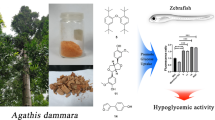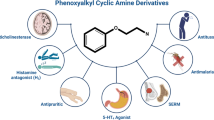Abstract
An EtOAc extract from the roots of Sophora flavescens (Kushen) potentiated γ-aminobutyric acid (GABA)-induced chloride influx in Xenopus oocytes transiently expressing GABAA receptors with subunit composition, α 1 β 2 γ 2S. HPLC-based activity profiling of the extract led to the identification of 8-lavandulyl flavonoids, kushenol I, sophoraflavanone G, (−)-kurarinone, and kuraridine as GABAA receptor modulators. In addition, a series of inactive structurally related flavonoids were characterized. Among these, kushenol Y (4) was identified as a new natural product. The 8-lavandulyl flavonoids are first representatives of a novel scaffold for the target.
Similar content being viewed by others
Abbreviations
- TOFMS:
-
Time of flight mass spectrometry
- PDA:
-
Photodiode array
- HMBC:
-
Heteronuclear multiple-bond correlation
- HSQC:
-
Heteronuclear single quantum coherence
- CD:
-
Circular dichroism
References
Simon J, Wakimoto H, Fujita N, Lalande M, Barnard EA (2004) Analysis of the set of GABAA receptor genes in the human genome. J Biol Chem 279: 41422–41435. doi:10.1074/jbc.M401354200
Olsen RW, Sieghart W (2008) International union of pharmacology. LXX. Subtypes of γ-aminobutyric acidA receptors: classification on the basis of subunit composition, pharmacology, and function. Update. Pharmacol Rev 60: 243–260. doi:10.1124/pr.108.00505
Barrera NP, Edwardson JM (2008) The subunit arrangement and assembly of ionotropic receptors. Trends Neurosci 31: 569–576. doi:10.1016/j.tins.2008.08.001
Sieghart W, Sperk G (2002) Subunit composition, distribution and function of GABAA receptor subtypes. Curr Top Med Chem 2: 795–816
Whiting PJ (2006) GABA-A receptors: a viable target for novel anxiolytics?. Curr Opin Pharmacol 6: 24–29. doi:10.1016/j.coph.2005.08.005
Riss J, Cloyd J, Gates J, Collins S (2008) Benzodiazepines in epilepsy: pharmacology and pharmacokinetics. Acta Neurol Scand 118: 69–86. doi:10.1111/j.1600-0404.2008.01004.x
Kaplan EM, DuPont RL (2005) Benzodiazepines and anxiety disorders: a review for the practicing physician. Curr Med Res Opin 21: 941–950. doi:10.1185/030079905X48401
Rupprecht R, Eser D, Zwanzger P, Moeller HJ (2006) GABAA receptors as targets for novel anxiolytic drug. World J Biol Psychiatry 7: 231–237. doi:10.1080/15622970600868525
Johnston GAR, Hanrahan JR, Chebib M, Duke RK, Mewett KN (2006) Modulation of ionotropic GABA receptors by natural products of plant origin. Adv Pharmacol 54: 285–316. doi:10.1016/S1054-3589(06)54012-8
Tsang SY, Xue H (2004) Development of effective therapeutics targeting the GABAA receptor: naturally occurring alternatives. Curr Pharm Design 10: 1035–1044. doi:10.2174/1381612043452767
Potterat O, Hamburger M (2006) Natural products in drug discovery—concepts and approaches for tracking bioactivity. Curr Org Chem 10: 899–920. doi:10.2174/138527206776894401
Potterat O, Wagner K, Gemmecker G, Mack J, Puder C, Vettermann R, Streicher R (2004) BI-32169, a bicyclic 19-peptide with strong glucagon receptor antagonist activity from Streptomyces sp. J Nat Prod 67: 1528–1531. doi:10.1021/np040093o
Danz H, Stoyanova S, Wippich P, Brattstroem A, Hamburger M (2001) Identification and isolation of the cyclooxygenase-2 inhibitory principle in Isatis tinctoria. Planta Med 67: 411–416. doi:10.1055/s-2001-15805
Dittmann K, Gerhaeuser C, Klimo K, Hamburger M (2004) HPLC-based activity profiling of Salvia miltiorrhiza for MAO-A and iNOS inhibitory activities. Planta Med 70: 909–913. doi:10.1055/s-2004-8326156
Kim HJ, Baburin I, Khom S, Hering S, Hamburger M (2008) HPLC-based activity profiling approach for the discovery of GABAA receptor ligands using an automated two microelectrode voltage clamp assay on Xenopus oocytes. Planta Med 74: 521–526. doi:10.1055/s-2008-1074491
Zaugg J, Baburin I, Strommer B, Kim HJ, Hering S, Hamburger M (2010) HPLC-based activity profiling: discovery of piperine as a positive GABAA receptor modulator targeting a benzodiazepine-independent binding site. J Nat Prod 73: 185–191. doi:10.1021/np900656g
Li Y, Plitzko I, Zaugg J, Hering S, Hamburger M (2010) HPLC-based activity profiling for GABAA receptor modulators: a new dihydroisocoumarin from Haloxylon scoparium. J Nat Prod 73: 768–770. doi:10.1021/np900803w
Khom S, Baburin I, Timin EN, Hohaus A, Sieghart W, Hering S (2006) Pharmacological properties of GABAA receptors containing γ1 subunits. Mol Pharmacol 69: 640–649. doi:10.1124/mol.105.017236
Methfessel C, Witzemann V, Takahashi T, Mishina M, Numa S, Sakmann B (1986) Patch clamp measurements on Xenopus laevis oocytes: currents through endogenous channels and implanted acetylcholine receptor and sodium channels. Pflug Arch Eur J Phy 407: 577–588
Baburin I, Beyl S, Hering S (2006) Automated fast perfusion of Xenopus oocytes for drug screening. Pflug Arch Eur J Phys 453: 117–123. doi:10.1007/s00424-006-0125-y
Wu LJ, Miyase T, Ueno A, Kuroyanagi M, Noko T, Fukushima S (1985) Studies on the constituents of Sophora flavescens Ait. III. Yakugaku Zasshi 105: 736–741
Sato S, Takeo J, Aoyama C, Kawahara H (2007) Na +-glucose cotransporter (SGLT) inhibitory flavonoids from the roots of Sophora flavescens. Bioorg Med Chem 15: 3445–3449. doi:10.1016/j.bmc.2007.03.011
Kim JH, Ryu YB, Kang NS, Lee BW, Heo JS, Jeong IY, Park KH (2006) Glycosidase inhibitory flavonoids from Sophora flavescens. Biol Pharm Bull 29: 302–305. doi:10.1248/bpb.29.302
Kuroyanagi M, Arakawa T, Hirayama Y, Hayashi T (1999) Antibacterial and antiandrogen flavonoids from Sophora flavescens. J Nat Prod 62: 1595–1599. doi:10.1021/np99000051d
Hatayama K, Komatsu M (1971) Studies on the constituents of Sophora species. V. Constituents of the root of Sophora angustifolia SIEB. et. ZUCC. Chem Pharm Bull 19: 2126–2131
Hillerns PI, Wink M (2005) Binding of flavonoids from Sophora flavescens to the rat uterine estrogen receptor. Planta Med 71: 1065–1068. doi:10.1055/s-2005-871302
Kyogoku K, Hatayama K, Komatsu M (1973) Constituents of Chinese drug, Kushen (the root of Sophora flavescens Arr.). Isolation of five new flavonoids and formononetin. Chem Pharm Bull 21: 2733–2738
Gaffield W (1970) Circular dichroism, optical rotatory dispersion and absolute configuration of flavanones, 3-hydroxyflavanones and their glycosides: determination of aglycone chirality in flavanone glycosides. Tetrahedron 26: 4093–4108. doi:10.1016/S0040-4020(01)93050-9
Luk KC, Stern L, Weigele M, O’Brien RA, Spirt N (1983) Isolation and identification of “diazepam-like” compounds from bovine urine. J Nat Prod 46: 852–861. doi:10.1021/np50030a005
Avallone R, Zanoli P, Puia G, Kleinschnitz M, Schreier P, Baraldi M (2000) Pharmacological profile of apigenin, a flavonoid isolated from Matricaria chamomilla. Biochem Pharmacol 59: 1387–1394. doi:10.1016/S0006-2952(00)00264-1
Ren L, Wang F, Xu Z, Chan WM, Zhao C, Xue H (2010) GABAA receptor subtype selectivity underlying anxiolytic effect of 6-hydroxyflavone. Biochem Pharmacol 79: 1337–1344. doi:10.1016/j.bcp.2009.12.024
Wang F, Xu Z, Ren L, Tsang SY, Xue H (2008) GABAA receptor subtype selectivity underlying selective anxiolytic effect of baicalin. Neuropharmacology 55: 1231–1237. doi:10.1016/j.neuropharm.2008.07.040
Wasowski C, Marder M, Viola H, Medina JH, Paladini AC (2002) Isolation and identification of 6-methylapigenin, a competitive ligand for the brain GABAA receptors, from Valeriana wallichii D. C. Planta Med 68: 934–936
Marder M, Viola H, Wasowski C, Fernandez S, Medina JH, Paladini AC (2003) 6-Methylapigenin and hesperidin: new valeriana flavonoids with activity on the CNS. Pharmacol Biochem Behav 75: 537–545. doi:10.1016/S0091-3057(03)00121-7
Svenningsen AB, Madsen KD, Liljefors T, Stafford GI, van Staden J, Jäger AK (2006) Biflavones from Rhus species with affinity for the GABAA/benzodiazepine receptor. J Ethnopharmacol 103: 276–280. doi:10.1016/j.jep.2005.08.012
Hanrahan JR, Chebib M, Davucheron NLM, Hall BJ, Johnston GAR (2003) Semisynthetic preparation of amentoflavone: a negative modulator at GABAA receptors. Bioorg Med Chem Lett 13: 2281–2284. doi:10.1016/S0960-894X(03)00434-7
Nielsen M, Frøkjaer S, Braestrup C (1988) High affinity of the naturally-occurring biflavonoid, amentoflavon, to brain benzodiazepine receptors in vitro. Biochem Pharmacol 37: 3285–3287. doi:10.1016/0006-2952(88)90640-5
Goutman JD, Waxemberg MD, Doñate-Oliver F, Pomata PE, Calvo DJ (2003) Flavonoid modulation of ionic currents mediated by GABAA and GABA C receptors. Eur J Pharmacol 461: 79–87. doi:10.1016/S0014-2999(03)01309-8
Hui KM, Huen MSY, Wang HY, Zheng H, Sigel E, Baur R, Ren H, Li ZW, Wong JTF, Xue H (2002) Anxiolytic effect of wogonin, a benzodiazepine receptor ligand isolated from Scutellaria baicalensis Georgi. Biochem Pharmacol 64: 1415–1424. doi:10.1016/S0006-2952(02)01347-3
Coleta M, Batista MT, Campos MG, Carvalho R, Cotrim MD, Lima TC, Cunha AP (2006) Neuropharmacological evaluation of the putative anxiolytic effects of Passiflora edulis Sims, its sub-fractions and flavonoid constituents. Phytother Res 20: 1067–1073. doi:10.1002/ptr.1997
Medina JH, Viola H, Wolfman C, Marder M, Wasowski C, Calvo D, Paladini AC (1998) Neuroactive flavonoids: new ligands for the benzodiazepine receptors. Phytomedicine 5: 235–243
Kavvadias D, Sand P, Youdim KA, Qaiser MZ, Rice-Evans C, Baur R, Sigel E, Rausch WD, Riederer P, Schreier P (2004) he flavone hispidulin, a benzodiazepine receptor ligand with positive allosteric properties, traverses the blood-brain barrier and exhibits anticonvulsive effects. Br J Pharmacol 142: 811–820. doi:10.1038/sj.bjp.0705828
Park SJ, Nam KW, Lee HJ, Cho EY, Koo U, Mar W (2010) Neuroprotective effects of an alkaloid-free ethyl acetate extract from the root of Sophora flavescens Ait. against focal cerebral ischemia in rats. Phytomedicine 16: 1042–1051. doi:10.1016/j.phymed.2009.03.017
Jin JH, Kim JS, Kang SS, Son KH, Chang HW, Kim HP (2009) Anti-inflammatory and anti-arthritic activity of total flavonoids of the roots of Sophora flavescens. J Ethnopharmacol 127: 589–595. doi:10.1016/j.jep.2009.12.020
Lipinski CA, Lombardo F, Dominy BW, Feeney PJ (1997) Experimental and computational approaches to estimate solubility and permeability in drug discovery and development settings. Adv Drug Deliv Rev 23: 3–25. doi:10.1016/S0169-409X(96)00423-1
Pajouhesh H, Lenz GR (2005) Medicinal chemical properties of successful central nervous system drugs. NeuroRX 2: 541–553. doi:10.1602/neurorx.2.4.541
Author information
Authors and Affiliations
Corresponding author
Additional information
Xinzhou Yang and Igor Baburin are equally contributed to this work.
Rights and permissions
About this article
Cite this article
Yang, X., Baburin, I., Plitzko, I. et al. HPLC-based activity profiling for GABAA receptor modulators from the traditional Chinese herbal drug Kushen (Sophora flavescens root). Mol Divers 15, 361–372 (2011). https://doi.org/10.1007/s11030-010-9297-7
Received:
Accepted:
Published:
Issue Date:
DOI: https://doi.org/10.1007/s11030-010-9297-7




